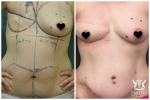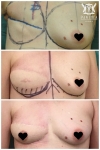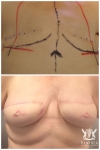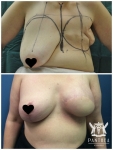Breast reconstruction surgery unfortunately is incredibly common today. The reason for this surgery is mostly due to infections, disease and cancer of the breasts. As a result of our lifestyle, humans are becoming sicker which can result in not only detrimental damage to the body but also to the breasts.
Breast cancer has become extremely common and because of this, mastectomies have followed in its footsteps. Following a mastectomy, which is the removal of the breast either as a preventative measure to prevent breast cancer, but also as a treatment to help remove cancer cells and stop them from spreading to the rest of the body, a mastectomy can leave a woman feeling less feminine and the loss of a breast or both breasts can have devastating consequences for the individual’s self esteem and confidence.
Why have Breast Reconstruction Surgery?
A breast reconstruction can get you back on track to feeling; healthy, sexy and confident.
Breast reconstruction surgery is an elective plastic surgery and it is used to rebuild the breast, building on the foundations that have been left behind, building the breast to its original size and shape.
Breast reconstruction can be done in one of two ways. The first technique is to remove the left over fatty tissue and skin of the breast and use an implant to bring the breast back up to its original size and shape. The second technique is where the surgeon will use fat transfer which is where fat from other parts of the body are used into the breast, however this technique can only be used if the nipple and areola is still intact.
The breast reconstruction takes place in two stages, which are both completed under general anaesthetic. The first stage is where your surgeon will place a small ‘tissue expander’ under the chest muscle and skin. This is done via a small incision in the natural crease underneath your breast. This tissue expander can almost be compared to a balloon and is made out of silicone. This tissue expander will have very little effect on how your breasts appear at first.
After around 14 to 21 days, you have to go back to see your surgeon who will inject a small amount of saline into a valve which is connected to the tissue expander. The injection of saline forces the tissue expander to increase gradually, slowly pushing the tissue around it to ensure that there is enough space for the breast implants. Once the surgeon has injected the tissue expander to the size of your choice, then the surgeon will stop and you will have to wait between one month and three months to ensure that the skin has been fully stretched out.
At the end of the three-month stretching period, stage two of the process begins. Stage two is the implant surgery. The surgeon will re-open the incision sight and remove the tissue expander. The surgeon will then replace it with the same shape and size breast implant. The implant will be placed and then the muscle layers will be surgically sutured to ensure that the implants do not move.
As this is serious surgery, it must be completed under a general anaesthetic and the individual must stay in hospital for up to a week after having the procedure. This hospital stay is to ensure no complications arise after the surgery. In addition, small drains will be placed inside the wound. This is to ensure that there is no fluid build-up around the breast. This will usually be removed, once the drain runs clear of blood, before going home.
Risks and Complications
Generally, modern day surgery is considered safe.
Breast reconstruction surgery has its risks and complications like all other surgeries, which must be conducted under general anaesthetic. The general anaesthetic itself has numerous risks that include; suppressed breathing, blood clots in the legs, blood clots in the lungs, heart failure and even death. Approximately one-third of patients who receive an anaesthetic during surgery will experience “anaesthesia sickness” or post-operative nausea and vomiting (POVN).
The risks and complications of having breast reconstructive surgery include:
Infection is a potential risk and if not treated immediately, can result in devastating consequences.
Infection is usually treated with a course of antibiotics, however if the infection spreads from the wound into the breast and around the breast implant itself, this can result in the implant having to be removed and the whole procedure having to be conducted again from scratch, after the infection clears up and your body has recovered.
Keloid scarring is another complication. Keloid is where the scar becomes raised and red, resulting in a very sore, ugly looking scar which usually results in the scar having to be removed and the incision line having to be re stitched.
Scar tissue can be a serious complication. As the body tries to heal itself, it forms scar tissue over the implant. Usually, the scar tissue is broken down after time, however some individuals are not as lucky and the scar tissue can start squeezing and constricting the implant resulting in the implant changing shape and causing your breasts to look uneven. If this happens the scar tissue will have to be surgically removed along with the implant.
Q. How long does breast reconstruction surgery take?
A. Every surgeon is different however the operation should not take more than two hours depending if there are any complications.
Q. Once I have the tissue expander in, will I look like I have breasts?
A. Unfortunately, having the tissue expander under your chest muscle will not make a difference as it is stretching the skin underneath the check muscle. As you reach the end of the expanding process, you will just start to notice a bulge in that area.
Q. Will my breast implants leak?
A. The statistics show that 1 in every 10 women will have a leakage or break in their implants in the first 10 years of having the surgery; this is due to natural wear a tear. If this does happen, then you will need to seek medical advice immediately as silicone bleeding can occur whereby the implants leak molecules of silicone into the blood stream. As the implants are so close to the lymph nodes under the arm pit, if the silicone molecules reach the lymph nodes, then this can cause redness and swelling.







